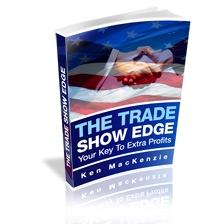
How to participate profitably in a trade showThe function of the exhibit is
to
Collect the facts ! It is a waste of time to go ahead with a design, never mind construction, of an exhibit whose purpose is to obtain new dealers to be faced with a comment by senior management that what is really needed is to identify a newly acquired product or service. The Sales Manager should realise right from the beginning what the exhibit is being planned to do. The Exhibit and the Show Visitor: Ideally, the design should attract every individual whom the exhibitor considers a prospect. The question can be stated as simply as this: "How do you design a trade show booth so you get the best results at various trade shows?" And here results mean telling your product story to more of the people who count in closing the sale. Here are ten rules for designing a booth: 1.It's a trade show ... so show them:
A show is exactly that......a show. It
is not an advertisement - it should be your product
in action! The visitor becomes immediately involved with
your product because he or she can see it, touch it, handle
it. The exhibitor has a great opportunity to act on all five
senses of the visitor. Don't throw this opportunity
away. 2.
Build your exhibit around your product:
Some exhibitors are more interested in
building pretentious displays than in showing the products
that they house. Do not look upon a show as an architectural
competition. This is always a mistake. 3. Make your
exhibit easy to
understand:
Show visitors want facts about your products and, they want
them quickly and in convenient form. Visitors are enthusiastic
about booths, which display products in orderly, logical
sequence. 4. Don't confuse
the visitor:The exhibitor whom uses unusual
sound effects razzle-dazzle displays or costumes often
creates the impression that he is trying to conceal his
product. 5. Show a maximum
number of
products:
Show a maximum number of products: Don't
just show a limited number of sizes or models. Visitors like to
see the complete line. Show actual products - not just
photographs of them. 6. Demonstrate
your product:
Visitors find static display boring.
They like dynamic displays they like to see the product in
action. Concentrate on one or two product features. A good
demonstration is simply tangible proof of the claims you
make for the product. 7. Show product
applications:The visitor will ask the fundamental
question: "What will your product do for
me?" 8. Encourage
audience
participation:It's great to be able to prove your
product's superiority to your visitor. It's even 9. Give him or her samples: All visitors like samples. Some visitors like souvenirs. Give them samples, if possible. Souvenirs don't do any harm, but they usually don't do any good. Admittedly, not all products are subject to samples, but a great many are. The difference between samples and souvenirs is that the souvenir is generally not relevant to the product. Let your visitor take your product back to the office in the form of samples. 10. Give the
visitor good technical
information:This subject is big enough for a
booklet of its own. It's still a matter of opinion as to
whether literature should be distributed at the show or
sent, after the show, to the visitor's office.
2006 - 2007 ©Copyright www.TheMarketingUpdate.com
|
| • | Business to Business Marketing | ||||||||||||||||
| • | Marketing Services-Public Relations | ||||||||||||||||
| • | Business to business marketing-Publicity Campaigns | ||||||||||||||||
| • | Print materials including brochures | ||||||||||||||||
| • | Corporate Relations | ||||||||||||||||
| • | The Framework of an Incentive Program | ||||||||||||||||
| • | Articles on organising an sales Incentive Program | ||||||||||||||||
| |||||||||||||||||
| • | Trade show participation, exhibitions and events | ||||||||||||||||
| • | Articles on Trade Show participation | ||||||||||||||||
| |||||||||||||||||
| • | International Trade Shows | ||||||||||||||||
| |||||||||||||||||
| • | James Schramko's Fast Web Formula 5 Workshop Australia Starts 20 March 2014 | ||||||||||||||||
| • | Visit my Blog | ||||||||||||||||
| • | Contact Us | ||||||||||||||||
| • | Some Interesting Sites | ||||||||||||||||
| • | Site Map | ||||||||||||||||
Copyright 2010 - 2013 Ken MacKenzie Communications




